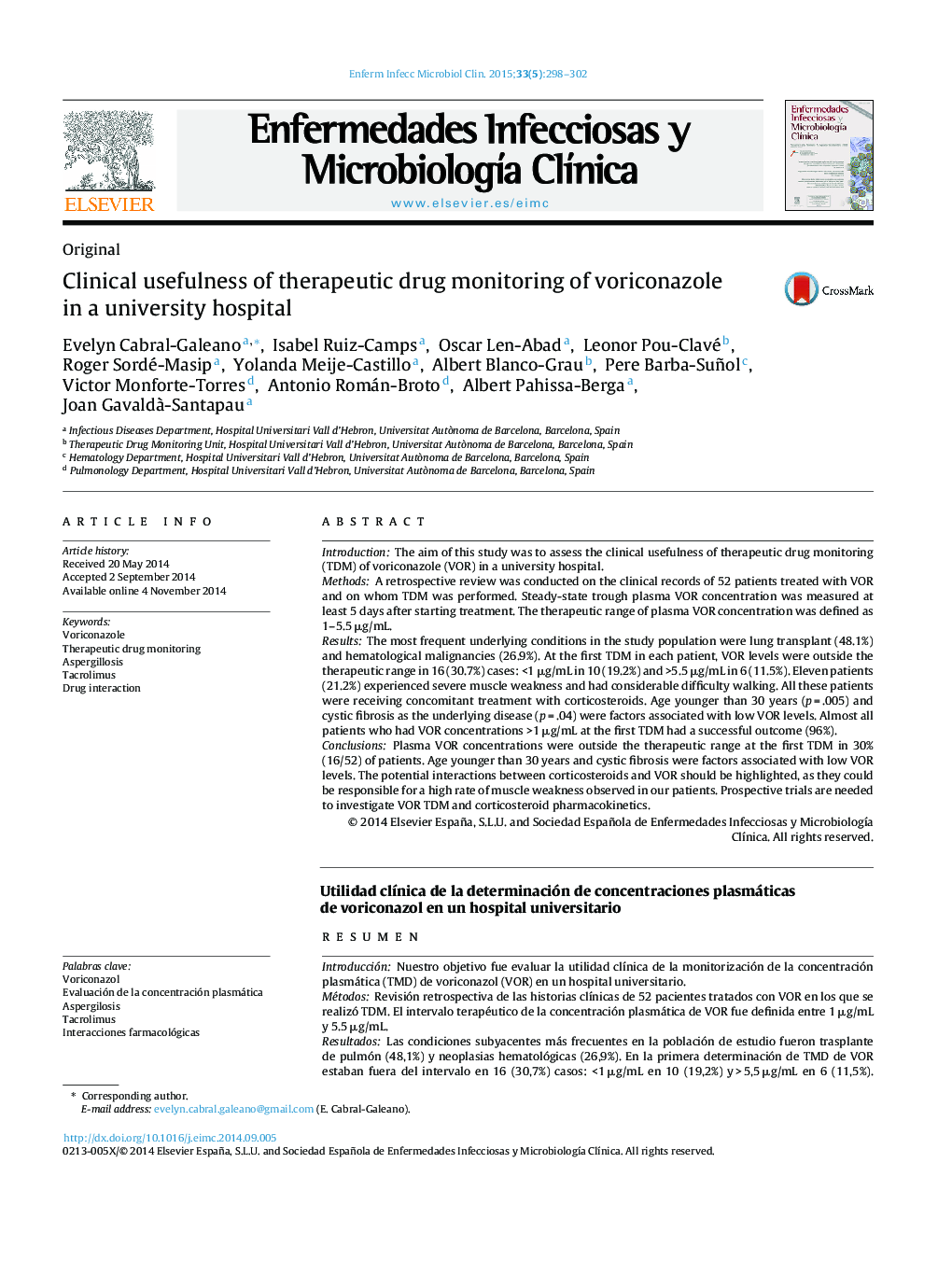| کد مقاله | کد نشریه | سال انتشار | مقاله انگلیسی | نسخه تمام متن |
|---|---|---|---|---|
| 3400730 | 1222627 | 2015 | 5 صفحه PDF | دانلود رایگان |

IntroductionThe aim of this study was to assess the clinical usefulness of therapeutic drug monitoring (TDM) of voriconazole (VOR) in a university hospital.MethodsA retrospective review was conducted on the clinical records of 52 patients treated with VOR and on whom TDM was performed. Steady-state trough plasma VOR concentration was measured at least 5 days after starting treatment. The therapeutic range of plasma VOR concentration was defined as 1–5.5 μg/mL.ResultsThe most frequent underlying conditions in the study population were lung transplant (48.1%) and hematological malignancies (26.9%). At the first TDM in each patient, VOR levels were outside the therapeutic range in 16 (30.7%) cases: <1 μg/mL in 10 (19.2%) and >5.5 μg/mL in 6 (11.5%). Eleven patients (21.2%) experienced severe muscle weakness and had considerable difficulty walking. All these patients were receiving concomitant treatment with corticosteroids. Age younger than 30 years (p = .005) and cystic fibrosis as the underlying disease (p = .04) were factors associated with low VOR levels. Almost all patients who had VOR concentrations >1 μg/mL at the first TDM had a successful outcome (96%).ConclusionsPlasma VOR concentrations were outside the therapeutic range at the first TDM in 30% (16/52) of patients. Age younger than 30 years and cystic fibrosis were factors associated with low VOR levels. The potential interactions between corticosteroids and VOR should be highlighted, as they could be responsible for a high rate of muscle weakness observed in our patients. Prospective trials are needed to investigate VOR TDM and corticosteroid pharmacokinetics.
ResumenIntroducciónNuestro objetivo fue evaluar la utilidad clínica de la monitorización de la concentración plasmática (TMD) de voriconazol (VOR) en un hospital universitario.MétodosRevisión retrospectiva de las historias clínicas de 52 pacientes tratados con VOR en los que se realizó TDM. El intervalo terapéutico de la concentración plasmática de VOR fue definida entre 1 μg/mL y 5.5 μg/mL.ResultadosLas condiciones subyacentes más frecuentes en la población de estudio fueron trasplante de pulmón (48,1%) y neoplasias hematológicas (26,9%). En la primera determinación de TMD de VOR estaban fuera del intervalo en 16 (30,7%) casos: <1 μg/mL en 10 (19,2%) y > 5,5 μg/mL en 6 (11,5%). Once pacientes (21,2%) experimentaron debilidad muscular, éstos pacientes recibían tratamiento concomitante con corticosteroides. Los Factores asociados con bajos niveles de VOR observados fueron la edad menor a 30 años (p= 0,005) y la fibrosis quística (p = 0,04). Casi todos los pacientes que tenían concentraciones VOR > 1 μg/mL en la primera TDM tuvieron un resultado satisfactorio (96%).ConclusionesEn 30% (16/52) de los pacientes, las concentraciones plasmáticas de VOR estaban fuera del intervalo terapéutico en la primera TDM. La edad menor a 30 años y la fibrosis quística fueron factores asociados con niveles bajos de VOR. Observamos una posible interacción entre corticoesteroides y voriconazol con debilidad muscular asociada en los pacientes tratados con ambos fármacos. Se necesitan estudios clínicos prospectivos en relación a las interacciones entre corticoesteroides y voriconazol.
Journal: Enfermedades Infecciosas y Microbiología Clínica - Volume 33, Issue 5, May 2015, Pages 298–302